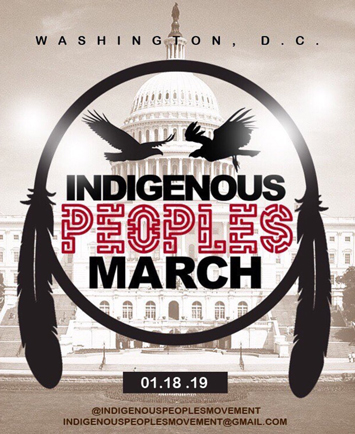'We Are Still Here!' - Indigenous people to march in nation’s capital
By Janiah Adams -Contributing Writer- | Last updated: Jan 8, 2019 - 9:46:01 PMWhat's your opinion on this article?
On Friday, Jan. 18, the U.S. will get a world view of indigenous people as they gather from across the world to attend the Indigenous Peoples March in Washington, D.C.

|
Members of indigenous tribes, nations and groups will come from North and South America, the Caribbean, Asia and Australia to stand in solidarity against injustices and address the critical issues that affect them.
Kelly Holmes, founder and editor-in-chief of Native Max Magazine said, the march is the first of its kind.
“There are marches all the time everywhere, but this march is to bring awareness to the injustices that affect indigenous women and children,” she said.
Ms. Holmes directs public relations for the march. She’s originally from the Cheyenne River Reservation in South Dakota. As a member of the Lakota tribe, she’ll unite with many other tribes at the march, which is something she’s also been able to do through her magazine.
“We all go through the same issues, and yet we all share the same passions, traditions, lifestyles ... our cultures are so similar. We’re able to really connect with each other,” she said. “It will bring the focus that hey, there are different indigenous people. We’re all from different groups and tribes and territories and nations.”
The Indigenous Peoples March is being organized by the Indigenous Peoples Movement coalition, which is comprised of members of several indigenous tribes, nations and groups from around the world.
Nathalie Farfan comes from the indigenous people of Ecuador but was raised in New Jersey. She’s part of the communications team for the march. “This is not a one-lens story,” she said. “We are very clear that this can’t just be about Native Americans because we are clear that indigenous people are struggling all over.”
She said some of the main issues they hope to address concern indigenous land and water. Poverty, health disparities and other pressing issues are what many indigenous communities face.
“I was at Standing Rock and it was unfortunate that it was a victory then it was a loss when the Trump administration came in,” she said.
They’re also fighting for some indigenous tribes to be federally recognized so that they can receive the benefits that come with it. There are currently well over 500 U.S. federally recognized tribes and over 300 U.S. federally recognized reservations. The population of Native American and Alaskan Natives in the U.S. is approximately 6.6 million. Recently, the first ever Native American women were elected to Congress; Deb Haaland (D-NM), a Laguna Pueblo and Sharice Davids (D-KS), of the Ho-Chunk Nation.
“They don’t get land that’s not tax-deductible, there are more scholarships in being recognized that allow kids to go get educated,” she said. “We’re fighting for asylum-seekers that Trump is putting in detention centers. They’re not criminals—they are people who have fundamental reasons for seeking asylum. And this is systemic racism at its best.”
One thing Ms. Holmes and Ms. Farfan believe, along with many indigenous people, is that they’re underrepresented in mainstream media, which is why not many people know about the issues they face, such as the alarming rate in which Native women and girls are disappearing.
“We’re fighting for Native American women, the highest murder and missing rate in the U.S. and still unaccounted for,” Ms. Farfan said.
The Associated Press reported that “at the end of 2017, Native Americans and Alaska Natives made up 1.8 percent of ongoing missing cases in the FBI’s National Crime Information Center database, even though they represent 0.8 percent of the U.S. population.”
Other issues culturalsurvival.com points out that will be addressed at the march is “voter suppression, divided families by walls and borders, an environmental holocaust, sex and human trafficking, and police/military brutality with little to no resources.”
Ms. Farfan said they’re currently working to build a platform of people who can help them to further the march’s cause beyond Jan. 18. “We’re asking for support to create a sustainable infrastructure of lawyers, translators and anyone in the marketing world and social media,” she said.
Ms. Farfan said those who will not be able to attend the march can visit indigenouspeoplesmovement.com for more information on how they can help.
“We are still looking for sponsors to help make this possible,” she said. “There are a lot of moving parts and a lot that’s going into the march.”
After the march, participants will rally and attend a concert that evening. Activists will also attend the Women’s March, which will be held the next day. (Final Call staff contributed to this report.)
INSIDE STORIES AND REVIEWS
-
-
About Harriett ... and the Negro Hollywood Road Show
By Rabiah Muhammad, Guest Columnist » Full Story -
Skepticism greets Jay-Z, NFL talk of inspiring change
By Bryan 18X Crawford and Richard B. Muhammad The Final Call Newspaper @TheFinalCall » Full Story -
The painful problem of Black girls and suicide
By Charlene Muhammad -National Correspondent- » Full Story -
Exploitation of Innocence - Report: Perceptions, policies hurting Black girls
By Charlene Muhammad -National Correspondent- » Full Story -
Big Ballin: Big ideas fuel a father’s Big Baller Brand and brash business sense
By Bryan Crawford -Contributing Writer- » Full Story






 Click Here Stay Connected!
Click Here Stay Connected!








